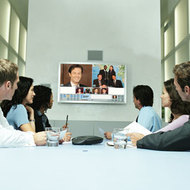- Broadcast-quality video and clear channel audio facilitate natural conversations, with users completely unaware of the enabling technology
- Available in a desktop-only configuration, conference room configurations, or a fully compatible combination
- Provides one-on-one and multi-party conferencing services, ad-hoc meeting capabilities, and fully integrated telephony services over highly reliable networks
- Supports operation over high-speed encrypted networks
- Features a SIP-based VoIP architecture for multi-site communications applications
- Offers easy-to-use touchscreen operation with an intuitive graphical user interface
- Requires very little training to operate
- Provides always-on availability for event-driven collaboration, a major advantage over scheduling a video conferencing room
- Integrates with existing private branch exchanges and the public switched telephone network
- Interoperates with traditional H.323- and H.320-based video conferencing systems
The most effective network appliance available to facilitate multimedia communications to locations around the world, ViPr can be used for a multitude of applications, including:
- Real-time briefings/situational decision making enhanced with collaboration and presentation media
- Real-time emergency response and preparedness communications
- International, national, statewide and countywide meetings
- Training
- Distance learning
- Real-time telemedicine
- Distributed teamwork
Key Features
- Personal desktop terminal + ViPr Virtual Share collaboration package
- Touch screen and user interface provide unparalleled ease of use
- Built-in conferencing and presentation capabilities make it easy to connect, disconnect, and interact with callers
- H.264, Session Initiation Protocol- (SIP-) based device provides full H.32x interoperability
- Ad-hoc conferencing capabilities for up to a 100-way conference call (no multi-conference unit [MCU] required)
- Presentation capabilities via a PC-to-ViPr connection
- Integration with Microsoft NetMeeting for instant collaboration sessions within a ViPr call
- Functions as your PC monitor while simultaneously acting as your video conferencing device
- Full-motion, full color video on a high-brightness, 17-inch TFT screen
- Active presence states maintained for call routing
- Follow-me (user logs in to receive calls at any terminal)
- Telephone features such as:
- Hold
- Transfer
- Speed dial
- Call forwarding
- Redial/call histories
- Ability to display video channel broadcasts
- Stereo quality output with volume control and integrated speakers
- Personal contact management
Performance Features
- Unequaled video quality based on the H.264 standard
- Wide-band audio
- Support for 10/100, 100FX, and ATM local area network connections
- Call modes that require bandwidth from 128 Kbps to 3 Mbps
- Low latency (~100 ms) for video encoding & decoding, providing real-time communications
- Call statistics provided through the end device user interface
- SIP support ranging from 128 Kbps to 3 Mbps
- H.323 and H.320 support ranging from 128 Kbps to 2 Mbps
- Individual placement of call participants to suit each person's viewing preference
- 30 frames per second of 640x480 video resolution
- Enhanced conference modes to display video participants in multiple views
- Concurrent “view call” windows and streaming video
- Simultaneously view your PC while participating in active ViPr calls
- View collaboration on the ViPr screen while participating in active calls
- S-Video inputs:
- Two S-Video inputs for VMC4000 and VMC4200
- Four S-Video inputs for VMC4400
- Progressive scan camera (internal)
- 1 extended graphics array (XGA) input (PC input), 1024x768, 60 Hz (VMC4200 and VMC4400 only)






